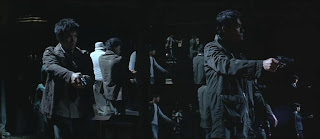As moviegoers, each one of us has our own dipstick for chaffing out films that are great from those that grate on our nerves. In my case, it is a simple matter of whether I am thinking ‘How will this end?’ as a film nears its dénouement or ‘When will this end?’ In other words, what I am watching has to be engaging enough to keep me guessing till its climax and well into it. Speaking of which, there is another hallmark for a memorable film, in my opinion. It either ends exactly where I thought it would (for example, Hitchcock’s Notorious [1946]) or it throws a curveball and floors me completely (for instance, Scream of Fear [1961]; The Ninth Configuration [1980]; Dead of Night [1945] among many others). What makes Nick Tomnay’s maiden feature film The Perfect Host (2010)—which he edited and wrote as well—based on his own short The Host (2001), tick is that it manages to tick all the right boxes.
The one-line descriptor for the film on IMDB: ‘A criminal on the run cons his way into the wrong dinner party where the host is anything but ordinary’, and the accompanying poster do both a service and a disservice to this unknown little gem. They give away the spine on which the story hinges. The trailer on YouTube is even worse. While viewing it, it will not take long for the discerning eye to spot a ‘twist’ in the tale.
Thankfully, The Perfect Host does not get affected by these inadvertent revelations primarily because it is not a one-trick pony. Like an offering from a gourmet chef, the film is multi-layered, with tantalising surprises galore.
The tone is set quite appetisingly, in one of the early sequences of the film, when John Taylor (Clayne Crawford), a career criminal on the run from the law after robbing a bank enters a departmental store to buy some medication for his heavily bleeding foot. At that precise moment, there occurs a stick up in the store by a revolver-wielding woman. In a darkly comic scene, when the thief asks the store owner to put all the cash in his register in a bag, the Chinese man asks ‘Paper or plastic?’ The woman settles for the latter—an obviously wrong choice, thereby auguring an incorrect decision that John will be making a few minutes later. Another important foreboding is weaved into the same sequence when John manages to outwit the robber, by pulling a gun on her, instead; followed by the store owner sticking a pistol at John’s face. Tables are turned, as they will continue to be, on quite a few occasions henceforth.
Desperately seeking a safe haven, armed with a lie, John manages to get inside the impressive house of Warwick Wilson (David Hyde Pierce, whose claim to fame is portraying Dr Niles Crane in the TV series Frasier). Warwick is an affable guy and a cleanliness freak with a curious gait, who is alone at home, busy preparing dinner for four of his old friends—Roman (Tyrees Allen), Rupert (Cooper Barnes), Chelsea (Annie Campbell), and Monica (Indira G Wilson)—when the doorbell rings.
Offering John an unlimited supply from his stock of red wine, while admitting ‘I’m a bit of a white man myself; red’s a bit heavy for my constitution’, Warwick Warwick
A film that effectively turns the ‘home invasion’ genre on its head—and is reminiscent of the Anurag Kashyap-penned, Ramgopal Varma-directed superlative Kaun (1999), sans Urmila Matondkar’s histrionics—The Perfect Host is one of those rare films that encourages us to listen carefully. For it peppers the dialogues—major chunk of the film is nothing but a tête-à-tête between Warwick and John—with clues. These clues pertain to both what is about to happen (‘Cleaning up your nasty mess’) as well as an insight into both their characters (‘You’re my guest and I’m glad you’re here, but you only got yourself to blame’). The essence of a dark comedy, laid down during the departmental store scene, is also kept intact with such classic lines (delivered to perfection by Pierce) as Warwick
While deftly handling the minimalist setting of his film, Tomnay displays that he is equally adept at visual metaphor. In one scene, to hide John from the eyes of a prying neighbour, Warwick Warwick
It will be thoroughly unfair to review The Perfect Host without showering accolades on David Hyde Pierce’s performance. It is indeed difficult to point out, after Malcolm McDowell’s Alex in Stanley Kubrick’s A Clockwork Orange (1971), another character on film who elicited so much dread while dancing.
At the same time, one does need to acknowledge that the film itself is not ‘perfect’. The barrage of twists that are infused into the last quarter of its 93-minute duration might appear to be an exercise in overkill for some. The prolonged flashback sequences, dealing with Taylor
However, what makes this under-seen, under-appreciated effort that flew under the radar a laudable one is that it relies largely on an intelligent interplay between two characters. It is a venture that reminds us and restores our faith in the fact that—in this age of CGI and ‘Bayhem’—there was a reason movies were labeled ‘talkies’ long time ago.
And for serving that sole purpose, if for nothing else, this is one host one would like to raise a toast to.
























